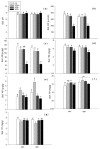Interaction Between Root Exudates of the Poisonous Plant Stellera chamaejasme L. and Arbuscular Mycorrhizal Fungi on the Growth of Leymus chinensis (Trin.) Tzvel
- PMID: 32143469
- PMCID: PMC7142538
- DOI: 10.3390/microorganisms8030364
Interaction Between Root Exudates of the Poisonous Plant Stellera chamaejasme L. and Arbuscular Mycorrhizal Fungi on the Growth of Leymus chinensis (Trin.) Tzvel
Abstract
The growth of a large number of poisonous plants is an indicator of grassland degradation. Releasing allelochemicals through root exudates is one of the strategies with which poisonous plants affect neighboring plants in nature. Arbuscular mycorrhizal fungi (AMF) can form a mutualistic symbiosis with most of the higher plants. However, the manner of interaction between root exudates of poisonous plants and AMF on neighboring herbage in grasslands remains poorly understood. Stellera chamaejasme L., a common poisonous plant with approved allelopathy, is widely distributed with the dominant grass of Leymus chinensis in the degradeds of Northern China. In this study, we investigated the addition of S. chamaejasme root exudates (SRE), the inoculation of AMF, and their interaction on the growth and tissue nitrogen contents of L. chinensis, the characteristics of rhizosphere AMF, and soil physicochemical properties. Results showed that SRE had significant effects on ramet number, aboveground biomass, and total nitrogen of L. chinensis in a concentration dependent manner. Additionally, SRE had a significant negative effect on the rate of mycorrhiza infection and spore density of the AMF. Meanwhile, the addition of SRE significantly affected soil pH, electrical conductivity, available nitrogen (AN), available phosphorus (AP), total nitrogen (TN), and total carbon (TC) contents; while neither inoculation of AMF itself nor the interaction of AMF with SRE significantly affected the growth of L. chinensis. The interaction between AMF and SRE dramatically changed the pH, AP, and TC of rhizosphere soil. Therefore, we suggested SRE of S. chamaejasme affected the growth of L. chinensis by altering soil pH and nutrient availability. AMF could change the effect of SRE on soil nutrients and have the potential to regulate the allelopathic effects of S. chamaejasme and the interspecific interaction between the two plant species. We have provided new evidence for the allelopathic mechanism of S. chamaejasme and the regulation effects of AMF on the interspecific relationship between poisonous plants and neighboring plants. Our findings reveal the complex interplay between the root exudates of poisonous plants and rhizosphere AMF in regulating population growth and dynamics of neighboring plants in degraded grassland ecosystems.
Keywords: AMF; allelopathy; degraded grasslands; interspecific relationship; root exudates.
Conflict of interest statement
The authors declare no conflict of interest.
Figures



References
-
- Meng B.P., Ge J., Liang T.G., Yang S.X., Gao J.L., Feng Q.S., Cui X., Huang X.D., Xie H.J. Evaluation of remote sensing inversion error for the above-ground biomass of alpine meadow grassland based on multi-source satellite data. Remote. Sens. 2017;9:372. doi: 10.3390/rs9040372. - DOI
-
- Feng X.M., Zhao Y.S. Grazing intensity monitoring in Northern China steppe: Integrating CENTURY model and MODIS data. Ecol. Indic. 2011;11:175–182. doi: 10.1016/j.ecolind.2009.07.002. - DOI
-
- Akiyama T., Kawamura K. Grassland degradation in China: methods of monitoring, management and restoration. Grass Sci. 2007;53:1–17. doi: 10.1111/j.1744-697X.2007.00073.x. - DOI
-
- Khan R.U., Mehmood S., Khan S.U. Toxic effect of common poisonous plants of district bannu, khyber pakhtunkhwa, pakistan. Pak. J. Pharm. Sci. 2018;31:57–67. - PubMed
-
- Holechec J. Do most livestock losses to poisonous plants result from “poor” range management? J. Range Manage. 2002;55:270–276. doi: 10.2307/4003134. - DOI
Grants and funding
LinkOut - more resources
Full Text Sources

